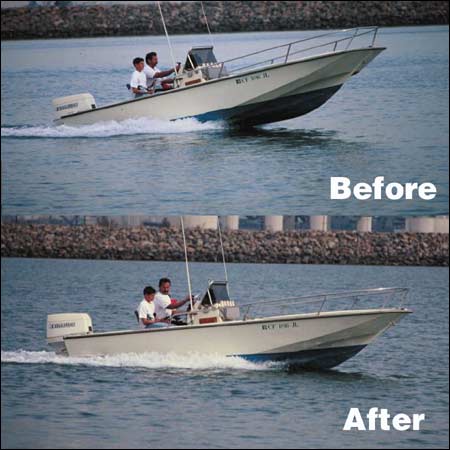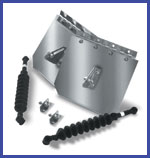

Smart Tabs
Courtesy of Steve Mills
Web site for Nauticus Inc
I'm not one to simply give up on a good idea just because it doesn't work out the first time. Often a little perseverance pays off, as you're about to find out.
On the face of it trim tabs do not appear to be as obvious accessory for a small angling craft, so I was a little cool when I heard about Smart Tabs, a new type of trim tab specifically designed for small leisure craft.
However, these tabs were claimed to not only improve acceleration but to assist boat balance and stability, which interested me because my Orkney Day Angler 19 does lean over to port very slightly when underway.
This can be a common problem for semi-displacement designed hulls and I was assured that Smart Tabs could cure all that and more.

Theory behind trim tabs
Trim tabs are simply a pair of plates installed at the base of the boat's transom. They are then angled down below the horizontal plane of the hull to, hopefully, provide lift and lateral stability.
Clearly if too little lift is applied they are ineffectual and if too much is applied they can impair performance. The simplest tab would be a fixed plate. The more sophisticated ones can be adjusted hydraulically to provide
independent and variable lift.
Any professional installation for even a small boat would probably cost in the region of £400 to £500 or more.
Smart Tabs offer an ingenious compromise. The ram or actuator that is positioned between the plate and transom is gas filled and provides thrust at a preset poundage. This poundage must be matched according to the size, weight and engine power available.
The plates are installed at a set down-angle of about 25 degrees. the actuators compress once the boat gets on underway providing the essential lift, which improves acceleration.
Once the correct poundage of thrust is matched to the boat the tabs automaticlly sit parallel to the hull at speed while continuing to provide balance.
Theory is relatively easy, the reality if practice more problematical. We estimated my Orkney would need 60lb gas actuators, wrong as it turned out.
I experienced far too much resistance and the excessively powerful lift actually impeded performance. I need to trim the engine out to counter the tabs. At least it proved they work.
Plastimo UK who market Smart Tabs, put me in touch with Nauticus Inc and the man who designed them, John DeAgro, who suggested I swapped the 60lb for 40lb actuators. I also learned how I could make further fine-tuning for maximum benefit.
For example, the attachment slot on the plate allows you to lock the actuator to increase or decrease the thrust. Further tuning should enable me to apply differential thrust to port and starboard tabs to counter the leaning. Now I can identify better handling at low speeds
and more rapid planning, which brings the bow down earlier and offers improved vision.
John revealed an important point about the effectiveness of tabs compared to foils or fins that are often bolted on outboard cavitation plates.
For maximum efficiency the propeller should be providing direct horizontal thrust. Trimming the engine in or out to lower or raise the bow is inefficient and you must use a higher throttle setting and more fuel.
Tabs provide lift separately allowing the engine to be set for maximum efficiency. With foils or fins to have any real effect on a boats balance the engine will have to be trimmed one way or another and this means the propeller will not be
providing optimum efficiency, for me tabs win that argument.
These are the costs
As with any innovative accessory you have to weigh up the pros and cons as to whether Smart Tabs are worth the investment. For a start there is the purchase price.
Tabs come in three plate sizes with five different actuator pressures and kit prices start around £130 plus VAT. The kit for my Day Angler retails at £170 plus VAT.
It should be noted that anyone competent with drill and screwdriver should be able to follow the clear installation instructions and fit the tabs in around two hours. The installation does involve drilling a number of holes into the back of your boat.


One potential problem with tabs is that they could get in the way if you either beach launch or need to bring the stern of the boat into shallow water. This problem can be simply eliminated with a cord and clam cleat kit that holds the tab up out of the way.
Finally, when using Smart Tabs in salt water it is necessary to attach a zinc anode for protection. The final question is will Smart Tabs catch me more fish? Unfortunately the answer is no, but they make your trips to and from the fishing grounds more comfortable and far more efficient.
Download the instruction manual here
Disclaimer: Everything written in these reports are based on personal experience and the individual's opinion only. I have tried my best to present the facts correctly, but I/we take no responsibility for any mistakes or omissions.